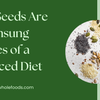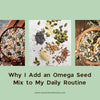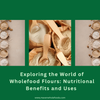How to Make Organic Oat Flour from Porridge Oats at Home
- by K V
Looking to incorporate more natural ingredients into your baking? Making organic oat flour at home is quick, cost-effective, and easy, providing you with a versatile, gluten-free flour that adds a nutty flavor and soft texture to your recipes. Whether you’re baking pancakes, muffins, or gluten-free bread, oat flour is a fantastic choice. Here’s a step-by-step guide on how to make it, followed by some delicious recipes to try.
What is Oat Flour?
Oat flour is a finely ground powder made from oats, typically whole, rolled, or quick oats. It’s a versatile, gluten-free alternative to traditional wheat flour, and it's known for its mild, slightly sweet flavor and soft texture. Because oats are naturally high in fiber, protein, and essential nutrients, oat flour has gained popularity in both health-conscious and gluten-free baking.
Comparison with Other Flours
Oat flour differs from other common flours in several ways:
- Wheat Flour: Wheat flour is a staple in most kitchens and is used widely in baking due to its gluten content, which helps provide structure and elasticity in baked goods. Unlike wheat flour, oat flour is gluten-free and has a more delicate texture, making it ideal for baked goods that don’t need to rise as much (like pancakes or muffins).
- Almond Flour: Almond flour is another popular gluten-free alternative, known for its slightly nutty flavor and higher fat content. While almond flour provides a rich texture and works well in dense, moist baked goods, oat flour is lower in fat and provides a milder flavor, making it more versatile for recipes like bread and cookies.
- Coconut Flour: Coconut flour is a gluten-free option that absorbs a significant amount of liquid, often requiring additional eggs or moisture in recipes. Oat flour, on the other hand, is less absorbent and tends to yield a softer texture.
Each flour brings unique characteristics to baked goods, and oat flour often works well in combination with others to create a balanced texture and flavor.
Nutritional Benefits of Oat Flour?
- High in Fiber: Rich in beta-glucan, a soluble fiber that supports heart health by reducing cholesterol levels and aids in maintaining stable blood sugar.
- Source of Protein: Contains more protein than many other gluten-free flours, helping with muscle repair and satiety.
- Rich in Essential Minerals: Provides manganese, magnesium, phosphorus, and iron, which are vital for bone health, energy production, and oxygen transport.
- Low Glycemic Index: Slows down the absorption of sugars, making it a good choice for those looking to avoid blood sugar spikes.
- Naturally Gluten-Free: Suitable for gluten-sensitive individuals when using certified gluten-free oats, making it a great alternative for those with celiac disease or gluten intolerance.
Making Oat Flour at home
Oat flour is simple to make at home. All you need is a blender or food processor to grind oats into a fine, flour-like consistency. Here’s a quick breakdown of how oat flour is created:
- Blending: Measure out whole, rolled, or quick oats and place them in a blender or food processor.
- Processing: Blend the oats on high until they reach a fine, powdery consistency.
- Sifting (optional): For an extra-fine flour, sift the mixture to remove any large pieces.
- Store-bought oat flour: undergoes a similar process, though it is often ground into a finer, more consistent texture than homemade versions. Additionally, it may be certified gluten-free, which is essential for people with celiac disease.
Types of Oats Used to Make Oat Flour
You can use a few different types of oats to make oat flour, each of which yields a slightly different consistency:
- Whole Oats: These are oats that are minimally processed and retain their bran and germ. Whole oats produce a coarser oat flour, which can add a rustic, hearty texture to baked goods.
- Rolled Oats: Rolled oats are steamed, flattened, and dried, creating a softer texture. They’re commonly used for homemade oat flour, as they’re easy to blend and create a relatively fine consistency, perfect for most baking needs.
- Quick Oats: Quick oats are similar to rolled oats but are processed into thinner, smaller pieces for faster cooking. They make a finer flour than whole or rolled oats, which can be useful for more delicate baked goods.
Using different types of oats in oat flour can slightly alter the texture of the final product, but all can be suitable depending on your recipe preferences.
Baking and Cooking with Oat flour
Fluffy Oat Flour Pancakes
Perfect for a weekend breakfast, these oat flour pancakes are fluffy, filling, and naturally gluten-free.
Ingredients:
- 1 cup oat flour
- 1 tbsp baking powder
- ½ tsp cinnamon
- 1 large egg
- 1 cup milk (or almond milk for dairy-free)
- 1 tbsp honey or maple syrup
- 1 tsp vanilla extract
Instructions:
- In a mixing bowl, combine the oat flour, baking powder, and cinnamon.
- In a separate bowl, whisk together the egg, milk, honey, and vanilla.
- Pour the wet ingredients into the dry and stir until combined.
- Heat a non-stick skillet over medium heat and add a bit of oil.
- Pour ¼ cup of batter for each pancake and cook until bubbles form on the surface, then flip and cook for another 1-2 minutes.
- Serve with your favorite toppings, like fresh berries or a drizzle of maple syrup.
Oat Flour Banana Muffins
These moist and tender muffins are naturally sweetened with banana and perfect for on-the-go snacking.
Ingredients:
- 1 ½ cups oat flour
- 1 tsp baking soda
- ½ tsp salt
- 1 cup mashed ripe bananas (about 2 large bananas)
- 2 large eggs
- ¼ cup honey or maple syrup
- ¼ cup melted coconut oil
- 1 tsp vanilla extract
Instructions:
- Preheat your oven to 350°F (175°C) and line a muffin tin with paper liners.
- In a bowl, mix the oat flour, baking soda, and salt.
- In another bowl, combine the mashed bananas, eggs, honey, coconut oil, and vanilla.
- Fold the wet ingredients into the dry, stirring until just combined.
- Divide the batter among the muffin cups, filling each about ¾ full.
- Bake for 18-20 minutes or until a toothpick inserted comes out clean. Cool on a wire rack.
Gluten-Free Oat Flour Bread
Soft, hearty, and perfect for sandwiches, this gluten-free oat bread is easy to make and deliciously wholesome.
Ingredients:
- 2 cups oat flour
- 1 cup gluten-free all-purpose flour
- 2 tsp baking powder
- ½ tsp salt
- 2 large eggs
- 1 cup yogurt (or dairy-free yogurt for a vegan option)
- 2 tbsp honey or maple syrup
- ¼ cup milk of choice
Instructions:
- Preheat your oven to 350°F (175°C) and line a loaf pan with parchment paper.
- In a bowl, mix together oat flour, all-purpose flour, baking powder, and salt.
- In another bowl, whisk the eggs, yogurt, honey, and milk until smooth.
- Add the wet ingredients to the dry ingredients and stir until a thick batter forms.
- Pour the batter into the loaf pan and smooth the top.
- Bake for 40-45 minutes, or until the bread is golden brown and a toothpick comes out clean.
- Let cool in the pan for 10 minutes, then transfer to a wire rack to cool completely.
Frequently Asked Questions (FAQs)
Is oat flour really gluten-free?
- Oats are naturally gluten-free, but they can often be cross-contaminated with gluten-containing grains during processing. To ensure your oat flour is completely gluten-free, use certified gluten-free oats, which are processed separately to avoid contamination. This is especially important for individuals with celiac disease or severe gluten sensitivity.
What’s the best way to store oat flour?
- To keep oat flour fresh, store it in an airtight container in a cool, dry place, such as a pantry or cupboard. For longer storage, you can refrigerate or freeze it to preserve freshness and prevent it from going rancid, especially in warmer climates. If kept in the freezer, oat flour can last for several months.
How long does homemade oat flour last?
- Homemade oat flour, when stored in an airtight container in a cool, dry place, will last about 1–3 months. If refrigerated, it can last up to 6 months, and when frozen, it can stay fresh for up to a year. Always check for any off smell or changes in texture before using, as these can indicate spoilage.





